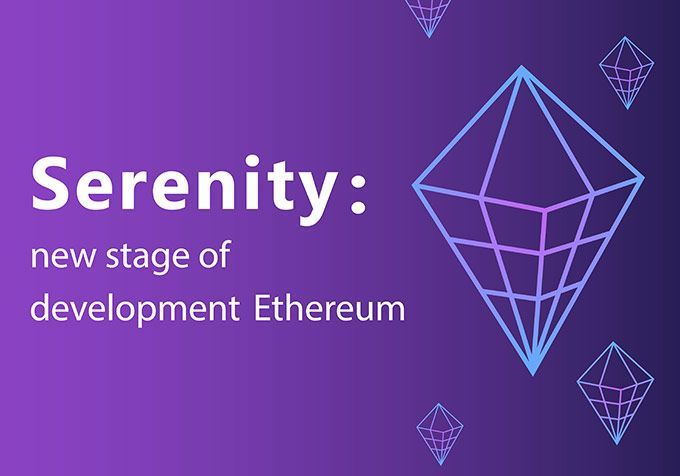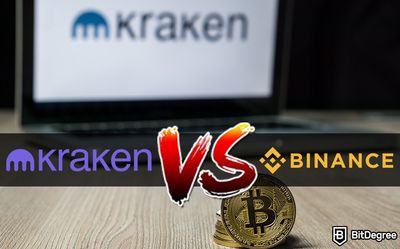Cryptocurrency forks are considered to be a rare occurrence in the crypto world. Some are planned, others - results of extreme situations. Whatever the case of their appearance might be, one thing’s for sure - when they happen, there are usually big changes ahead. That’s why today we’ll talk about Ethereum fork (hard forks, to be more exact).
We will cover the definitions of forks in general (what they are, why they happen and so on). After that, we’ll focus on the Ethereum forks - you’ll find out when they happened, what they changed and what the future holds.
Also, before moving further, you should be aware of the fact that cryptocurrencies must be stored in a safe place at all times. So, always choose the most secure and reliable crypto wallets, or, alternatively, top-rated exchanges, such as Binance, Coinbase, and Kraken.

Did you know?
Want to get smarter & wealthier with crypto?
Subscribe - We publish new crypto explainer videos every week!
What is Tezos? XTZ Cryptocurrency Easily Explained (ANIMATED)


Table of Contents
What is a Fork?
A fork in the cryptocurrency world is known as a change in that currency's protocol. This type of change makes previous versions of blocks valid and the current version invalid (or the other way around).
Latest Deal Active Right Now:
CLAIM $600 REWARD
Exclusive Binance Referral Code
Don't miss this limited-time deal that's only available for our readers. Use the Binance referral code 49316610 & receive up to $600 in rewards and bonuses!
There are two types of forks known as soft forks and hard forks.

Soft forks are the watered-down version of hard ones. They are called soft because they don’t change anything surrounding the actual structure of the protocol. Soft forks can be implemented by the developers or creators of the cryptocurrency to perform certain maintenance works, modify something cosmetically or change some of the rules surrounding the blockchain.
Some of the more popular and frequent soft forks are those which change the size of a specific block. They are often implemented by the developers to smoothen out the mining processes (assuming that we’re talking about a cryptocurrency that uses the “Proof of Work” consensus).
These forks become temporary ones - some miners may choose to use them, while others can just reject the change and continue mining the older versions of the coin.
Hard forks, however, are a whole different story.
Hard forks are huge changes to the cryptocurrency in question. They change the cryptocurrency's protocol itself, rendering the older versions of that protocol invalid. If it (the older version) continues to live on, it will result in a split from the new version. Ethereum has such examples, and we shall talk about them in the upcoming paragraphs.
Hard forks are usually implemented under extreme conditions. They are rarely planned - most of the time their appearance is due to necessity. This makes sense because there are usually no legitimate reasons to implement a hard fork in a normally functioning cryptocurrency. The keyword is usually, though - as you'll see soon enough, Ethereum is an exception.
Now that we are more or less on the mutual ground and have gotten the terminology out of the way, let’s move on to the main topic - Ethereum hard forks.
Ethereum Hard Forks
The main reason why we’re specifically talking about Ethereum HARD forks is that they are so detrimental and significant to Ethereum’s well-being, that it becomes impossible to ignore.
Ethereum Classic, EtherZero and Metropolis - these are the main three Ethereum hard forks, and we’ll talk about each of them to an extent.
Ethereum Classic
This is the very first hard fork that Ethereum had. It is also the most controversial of all of the ETH's hard forks.

At a certain point in time, the development team behind Ethereum noticed that the decentralized autonomous organization (DAO) that Ethereum had been using was hacked. The decision to implement a hard fork that would restore all of the stolen crypto coins was swift, but it also received quite some backlash.
Ethereum supporters and enthusiasts divided into two camps. The first ones we’re happy that the team behind this cryptocurrency was going to take quick action and not let such a thing pass. A hard fork would mean that the developers have learned their lesson and are now better prepared for similar future attempts of a hack or a breach.
However, a lot of people didn’t agree with the hard fork. They saw this change as a violation of the fundamental meaning of "decentralized". This group of people believed that the only way to have a truly decentralized cryptocurrency was to not get involved and simply go by the flow because as soon as the developers start taking action, this would cause a ripple effect and would become a huge statement for the future.
Ultimately, Ethereum’s developers followed through with their decision to implement the hard fork. What was the outcome? Well, one cryptocurrency split into two.
The majority of the people that didn’t agree with the split ended up sticking to the old version of Ethereum, which is now known as Ethereum classic.
Today, there are still two camps of people in the cryptocurrency community - some think that the developers were right to fix the problem as soon as possible, while others commend the people that stuck to their beliefs and are still supporting Ethereum Classic.
Ether Zero
EtherZero is another well-known Ethereum fork. It’s not as extreme as Ethereum Classic - this one is aimed towards improvement rather than a revolution.

EtherZero aims to improve the transaction rate speeds that occur within the Ethereum network. Furthermore, this Ethereum fork is determined to make these transactions completely free.
Many in the cryptocurrency world consider these to be very bold objectives. EtherZero is also a “Proof of Work” based fork - this means that the only truly effective way to mine it would be by using GPU types of rigs. Although it is worth mentioning that there are plans to implement a masternode (“Proof of Stake”) system into this Ethereum fork in the future.
Metropolis
Metropolis is the current Ethereum fork. This fork wasn’t created because of any extreme situations, though - it’s part of a plan to improve the existing Ethereum blockchain.
Metropolis is composed of three phases. The phase of “Constantinople” is currently the active one (Byzantium is considered to have ended).

There are a couple of key features that the Metropolis Ethereum fork aims to improve.
First of all, during the extent of the Ethereum Metropolis fork, a lot of the privacy-related features will get an overhaul. The current privacy settings and options that the Ethereum network has aren’t at all bad, but the new features will be up to date and will guarantee greater privacy during transactions.
Another huge change that the Ethereum Metropolis fork aims to implement is a “Proof of Stake” consensus-based system, instead of the current “Proof of Work” one.
If this would be done, this would eliminate Ethereum mining as a whole. Instead, you would stake some of your Ethereum coins for the ability to automatically verify transactions happening on the Ethereum blockchain, and in turn, would receive a certain amount of revenue.
Ethereum mining (GPU, CPU, ASIC, Cloud) is an extremely popular activity among these crypto coin’s fans, so this is a big point of discussion. Even though the PoS system would theoretically hasten and smoothen the processes happening within the network, such a change would result in a massive mining equipment dump into the market, which could mean detrimental price changes of mining rig components.
Let’s quickly overview two of the Ethereum Metropolis fork’s phases.
Byzantium was a phase which aimed to make the Ethereum platform more secure and better optimized. This was done one step at a time, but the initial goal was to make the network safer and more fluid to use.
Constantinople aims to finish off the processes of Byzantium and then concentrate on one big goal - to prepare the Ethereum blockchain for the transition between PoW and PoS systems. This is a huge goal in of itself and will require quite some time to be fully set into motion.

Did you know?
Want to get smarter & wealthier with crypto?
Subscribe - We publish new crypto explainer videos every week!
Can Russia Use Crypto to Bypass Sanctions? (Animated)



- A very well-known crypto exchange platform
- More than 500 different cryptos available
- Two-factor authentication
- Over 500 different cryptocurrencies available
- Strong security
- Small withdrawal fees

- Very low trading fees
- Exceptional functionality
- Mobile trading app
- Very competitive trading fees
- An intuitive mobile app
- Up to 100x leverage available

- Secure and reliable
- Low fees
- A good amount of fiat currencies accepted
- Reputable exchange
- Multiple fiat currencies are accepted
- Relatively low trading fees
Serenity
Ethereum Serenity is considered to be the last big step in Ethereum’s development. Serenity is dedicated to one goal, and one goal only - to transition the Ethereum blockchain from PoW to PoS.

Byzantium and Constantinople are the two main preparation phases. During this time, certain transactions will be made via the Proof of Stake consensus to start preparing the system for the transition.
Ethereum Serenity is a huge milestone for Ethereum because it would practically change everything that people are used to when it comes to this crypto’s mining. According to the Ethereum roadmap, the transition to “pure PoS” should happen sometime in 2023.
Ethereum Fork Summary
Let’s make a quick rundown of what we’ve covered in this ETH hard fork guide.
Cryptocurrency forks are events within the cryptocurrency's blockchain that aim to change certain specific aspects of the crypto in question. There are two types of forks - soft ones and hard ones.
Soft forks change minor and cosmetic issues, while hard forks are usually complete game-changers.
Throughout Ethereum’s lifespan, there have been (and still will be) three big ETH hard forks - Ethereum Classic, EtherZero, and Metropolis.
The Metropolis Ethereum fork (which is the current fork) ultimately aims to prepare Ethereum for the transition between a Proof of Work system-based altcoin into a Proof of Stake one.
Serenity will be the final step in completing the above-mentioned task and is scheduled to happen at some point in time in 2023.
Conclusion
The world of cryptocurrencies is constantly finding new and different ways to develop and advance, whether it be from a technological perspective or information-wise.
Cryptocurrency forks are usually very controversial events within the crypto communities. It does depend on what the fork upgrades or changes, but no matter the intent, people will still always be divided into groups of two - those who like it, and those who hate it.
Soft forks are generally accepted more easily than hard ones. This is mostly due because they don’t aim to fundamentally change anything within the blockchain. Most of the people might even like some soft forks - especially the cosmetic-alternating ones.
However, hard forks are always a point of discussion. The changes that they bring are rarely taken with a one-sided reaction.
Ethereum forks are interesting. All three of the hard ones have been very important breaking points in Ethereum’s lifespan. Ethereum Classic was the most controversial one, though - this hard fork sparked major philosophical discussions within the cryptocurrency communities worldwide. For the first time, the topic of decentralization became so widely referenced and discussed.

As much as Ethereum Classic was controversial, the Metropolis Ethereum fork is significant.
As soon as Ethereum Serenity kicks into play, no one knows what will happen to the economy. There will suddenly be thousands and thousands of mining rigs, GPUs, ASICs, and other cryptocurrency mining-related devices that will no longer serve a use.
People are usually not ready for such dramatic changes. Naturally, a portion of the crypto mining population will find certain specific loopholes and ways out - resell the GPUs, rent out rigs or even start mining other cryptocurrencies, forgetting Ethereum as a whole.
The last part would probably be the worst-case scenario for Ethereum. All of the cryptocurrencies are worth as much as people use them - if the number of users declines, so will the crypto’s relevancy and, in turn, its price.
That is why, at least when it comes to this Ethereum fork, a lot of preparation and effort has been put in beforehand - Serenity isn’t due until next year, and the development team hopes to ease some of the initial backlashes that this hard fork garnered.
One of the main goals for the Ethereum team is to show just how beneficial and fast a Proof of Stake system is when compared to a Proof of Work one. It eliminates a lot of the PoW system’s flaws (electricity, cooling and device costs, a need for a huge and open area, etc.).
Also, the amount that someone gets paid out to them depends on the amount that they staked - the more you bring to the table, the more you get. This incentivizes people to participate in trading, buying and selling - all to get more coins and earn bigger revenue.
Also, if you have a generous amount of Ether, you should make sure to keep it in a safe place and choose hardware wallets, such as Ledger Nano X and Trezor. If you fancy hot wallets, though, you could keep some of your crypto on top-rated exchanges - examples include Binance, Coinbase, and Kraken, among others.
Well, this was the Ethereum fork guide. I hope you found it interesting and have learned something new about Ethereum and other forks in general!













